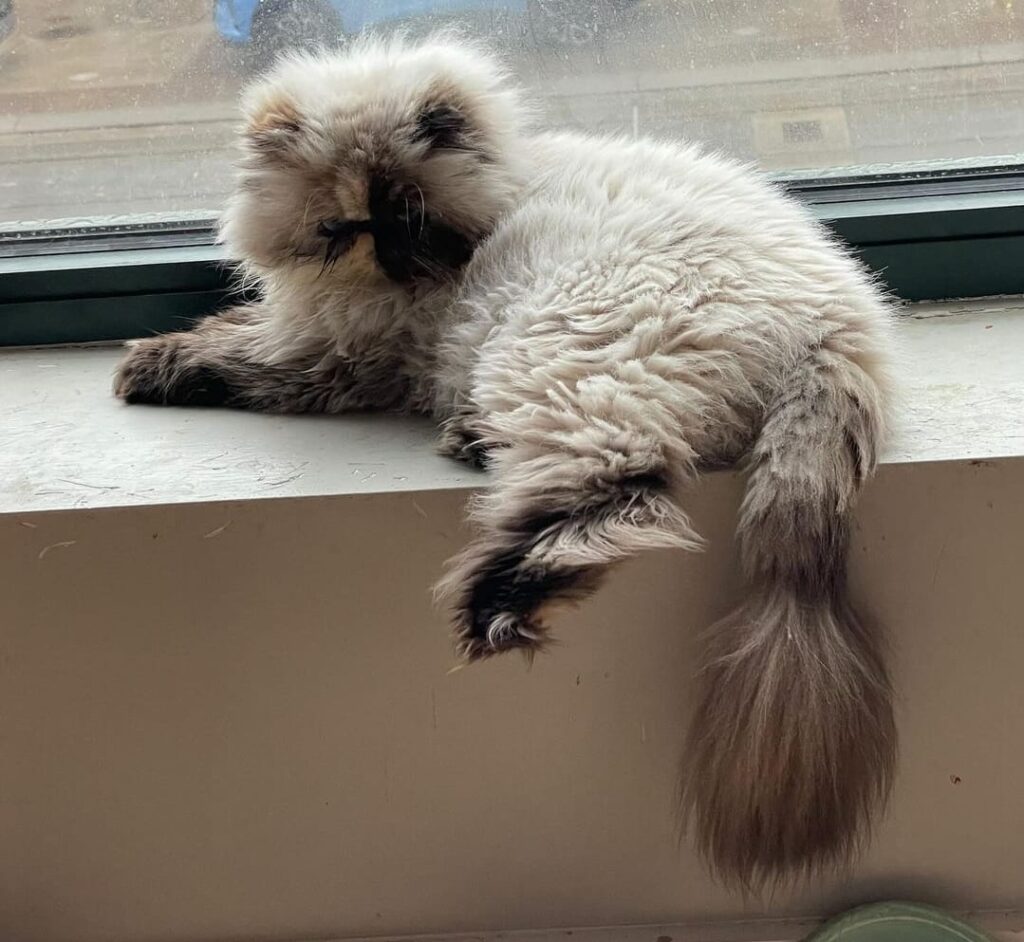Owning a Himalayan cat is a rewarding journey filled with fluffy cuddles and purring affection. Their unique mix of Persian grace and Siamese intelligence makes them fascinating companions.
This guide aims to walk you through every aspect of caring for your Himalayan, ensuring their happiness and health.

Introduction to Himalayan Cats
Himalayan cats, with their luxurious fur and striking blue eyes, are the epitome of feline beauty.
Originating from the crossbreeding of Persian and Siamese cats, they combine the best of both worlds: the Persian’s serene demeanor and the Siamese’s playful nature.
This guide dives deep into the essentials of Himalayan care, from their need for a serene living environment to the specifics of their grooming routine, ensuring your cat enjoys a life of comfort and contentment.
Before proceeding if you’re wondering How does a Himalayan cat look like, check out – “What Does a Himalayan Cat Look Like?“
Living Environment: Creating a Himalayan Haven
Indoor vs. Outdoor
Himalayan cats are better suited to the indoors, where dangers such as traffic and predators are non-issues.
These cats appreciate a stable environment filled with stimulating toys and comfortable resting places, ensuring they remain safe while satisfying their curiosity and need for play.
Providing a Secure Space
Every Himalayan cat cherishes having a personal retreat within the home. This space should be quiet and cozy, equipped with a comfortable bed, scratching posts, and a selection of toys.
It’s a place where they can unwind and feel secure, away from the hustle and bustle of daily life.
Grooming and Hygiene: The Key to a Healthy Coat
Regular Grooming Importance
Himalayan cats require daily grooming to manage their long, thick fur.
This routine prevents mats, reduces hairballs, and keeps their coat shiny.
Regular grooming sessions also serve as bonding moments, strengthening the emotional connection between you and your cat.
Eye and Ear Care
Given their brachycephalic facial structure, Himalayans often need extra care in keeping their eyes clean and free from tear stains.
Regular, gentle cleaning prevents discomfort and infections. Similarly, their ears should be checked and cleaned regularly to prevent wax build-up and mites.
Dental Hygiene
Maintaining your Himalayan’s dental health is crucial. Regular brushing, coupled with annual dental check-ups, prevents periodontal disease, ensuring your cat’s teeth remain healthy throughout their life.
Health Care and Nutrition: Foundations of Feline Wellness
Regular Vet Check-ups
Consistent veterinary care is essential for Himalayans. Regular check-ups can catch health issues early, and keeping up with vaccinations and parasite control helps prevent common diseases, ensuring your cat stays healthy and vibrant.
Balanced Diet
A balanced diet tailored to their specific needs is vital for Himalayans.
High-quality cat food that supports their coat and overall health, alongside access to fresh water, will nourish your cat, keeping them happy and healthy.
Exercise and Mental Stimulation: Keeping Your Cat Engaged
Physical Activity
Though Himalayans might seem laid back, they still require daily exercise.
Engage them with interactive toys or laser pointers to encourage movement, helping maintain their physical health and prevent obesity.
Mental Engagement
Mental stimulation is just as important as physical activity for Himalayans.
Puzzle toys, new environments to explore, and regular playtime can keep their minds sharp and prevent boredom, enriching their daily lives.
Emotional Well-being: Understanding and Bonding
Companionship and Affection
Himalayans thrive on affection and companionship. They form deep bonds with their owners and need regular interaction and love to feel secure.
Dedicate time each day for cuddles, play, and conversation, nurturing a strong, loving relationship.
Training and Positive Reinforcement
Training Himalayans with positive reinforcement can be rewarding.
They respond well to treats and praise, making it possible to teach them tricks or encourage good behavior, enhancing your communication and strengthening your bond.
Managing Stress and Anxiety
Recognizing and Alleviating Stress
Himalayans, like all cats, can experience stress and anxiety. Creating a stable, peaceful environment, along with familiar routines, helps minimize stress. For high-stress situations like vet visits or moving, consider using calming pheromones or consult your vet for advice.
Related Topic – “Are Himalayan Cats Friendly?“
Integrating with Other Pets
Gradual Introductions
Introducing a Himalayan to other pets should be done slowly and with care. Controlled, supervised interactions help ensure that all animals get accustomed to each other peacefully, fostering a harmonious multi-pet household.
Catering to Life Stage Needs
From Kittenhood to Senior Years
The care needs of Himalayans change as they age. Kittens require ample socialization and vaccinations, adults need routine health checks and mental stimulation, and seniors may need dietary adjustments and more comfortable living arrangements to accommodate any health issues.
Debunking Myths
High Maintenance?
While it’s true that Himalayans require regular grooming, their overall care is manageable with a little dedication.
Their loving nature and majestic presence more than compensate for the effort, making them wonderful companions for those willing to invest the time.
Conclusion: The Joy of Himalayan Cat Ownership
Caring for my Himalayan cat has been an enriching experience, combining attentive grooming with heartfelt companionship. Each moment spent together, from brushing their luxurious fur to enjoying their peaceful company, has deepened our bond.
This journey of nurturing a Himalayan cat has truly been a testament to the deep, rewarding connection that flourishes from understanding and lovingly attending to their unique needs.

FAQs
Are Himalayan cats hard to take care of?
No, Himalayan cats aren’t hard to care for, but they require daily grooming to maintain their coat. Regular vet check-ups and a loving environment ensure their well-being.
How do you take care of a Himalayan?
To care for a Himalayan cat, provide daily grooming to prevent mats, offer a balanced diet, regular vet check-ups, and create a loving environment with interactive playtime.
Should I bathe my Himalayan cat?
Yes, bathing your Himalayan cat is recommended to keep its coat clean and free from dirt and oils. However, it’s essential to use cat-safe shampoo and ensure thorough rinsing to prevent skin irritation.
How often should I groom my Himalayan cat to keep their coat in good condition?
Daily grooming is essential for Himalayan cats to prevent matting and maintain their luxurious coat. Use a suitable brush to carefully detangle their fur, focusing on prone areas.
What kind of diet is best for a Himalayan cat?
A balanced diet rich in proteins and fats is ideal. Look for cat food formulated for long-haired breeds or consult your vet. Fresh water should always be available.
How can I ensure my Himalayan cat gets enough exercise?
Incorporate interactive toys like feather wands or puzzle feeders for daily play sessions to stimulate their natural instincts and prevent obesity.
What are the common health issues in Himalayan cats, and how can I prevent them?
Respiratory problems, kidney disease, and dental issues are common. Regular vet check-ups, a balanced diet, and good dental hygiene can help prevent or manage these conditions.
How can I reduce stress and anxiety in my Himalayan cat?
Maintain a calm environment, provide secure hiding spots, and use calming pheromones. Gradually introduce changes and ensure regular, gentle interaction and playtime.


